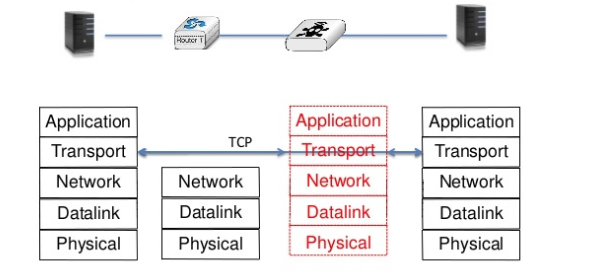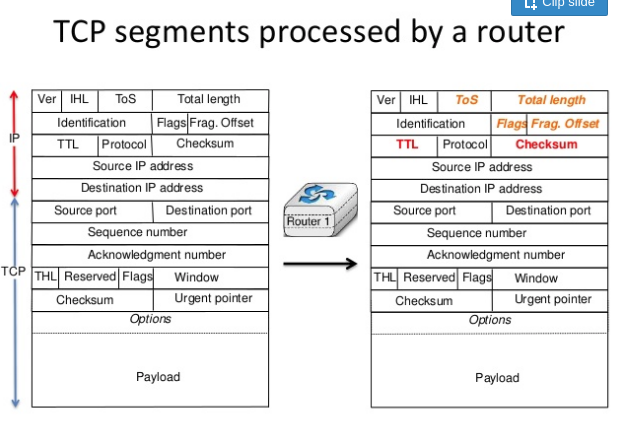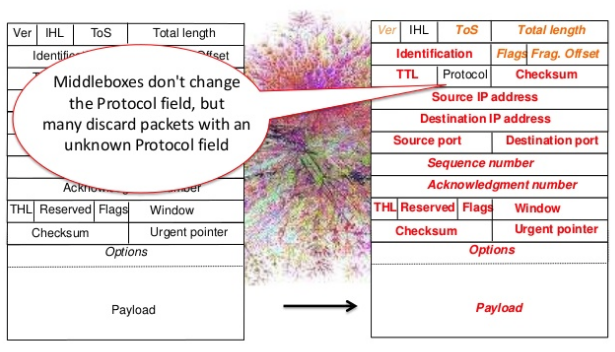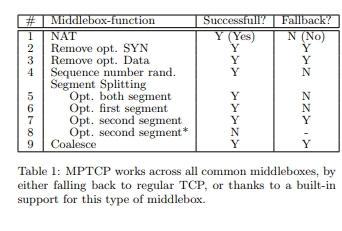Can Multipath TCP cope with middleboxes ?
As explained in a previous blog post, Multipath TCP had to cope with a variety of middleboxes which could interfere with this TCP extension.
Shortly after we detected the first interferences between a firewall and Multipath TCP, Honda et al. presented a detailed analysis [HNR+11] of the limits of the extensibility of TCP based on Internet measurements. To correctly understand the problems caused by middleboxes, we first need to remember that they can operate in any layer of the protocol stack as illustrated in the figure below.

When a router forwards an IPv4 packet that contains a TCP segment, it may modify some fields of the IPv4 header but never changes any field of the TCP header. This is one of the basis of the layering principles.

Middleboxes are different. As they potentially operate in any layer of the protocol stack, they can potentially change any field of the packet headers, in any layer. Some of them also modify packet payloads.

The main difficulty in such a network environement is that the TCP state on the client and on the server are updated based on information carried out inside packets. When the information placed in these packets changes after their transmission by one of the communicating hosts, this can create strange problems. Several of the functions of the Multipath TCP were designed to cope with middlebox interference. Here are a few examples :
- During the three-way handshake, the client sends the MP_CAPABLE option in the third ack to cope with a middlebox that could remove it from the SYN+ACK
- The ADD_ADDR, REMOVE_ADDR and MP_JOIN option contain an address identifier to cope with Network Address Translation
- The DSS option uses relative sequence numbers to cope with middleboxes that randomize the initial TCP sequence number
- The DSS option maps of block of data from the bytestream onto the TCP subflow. The length field of the DSS option allows to cope with middleboxes (or fast NICs) that segment/reassemble packets
- The DSS option contains a Checksum to cope with middleboxes that add/remove bytes in the payload
Multipath TCP and its implementation in the Linux kernel can cope with these interferences and others. This makes Multipath TCP very robust compared to older TCP extensions. An example with a strange middlebox was published in another blog post.
A detailed analysis of the reactions of Multipath TCP against those interferences was published in [HDP+13]. In some cases, Multipath TCP reacts by closing the subflow that passes through this middlebox. In other cases, it fallsback to regular TCP. A summary of this analysis may be found in the table below.

If you suspect that there is a middlebox that interferes with Multipath TCP connections on a path, you can use tracebox [Gre] to detect the location of this middlebox. Examples of the utilisation of tracebox on Linux/MacOS and Android appeared on earlier blog posts.
References
| [Gre] | Detal Gregory. \texttt tracebox. http://www.tracebox.org. |
| [HDP+13] | Benjamin Hesmans, Fabien Duchene, Christoph Paasch, Gregory Detal, and Olivier Bonaventure. Are TCP Extensions Middlebox-proof? In Proceedings of the 2013 Workshop on Hot Topics in Middleboxes and Network Function Virtualization (HotMiddlebox). 2013. URL: https://inl.info.ucl.ac.be/publications/are-tcp-extensions-middlebox-proof.html. |
| [HNR+11] | M. Honda, Y. Nishida, C. Raiciu, A. Greenhalgh, M. Handley, and H. Tokuda. Is it still possible to extend TCP? In Proceedings of the 2011 ACM SIGCOMM conference on Internet Measurement Conference (IMC). 2011. |